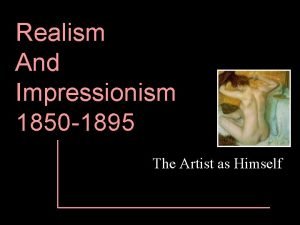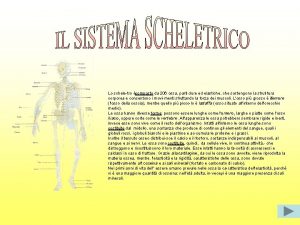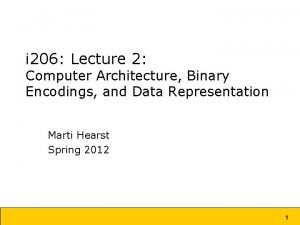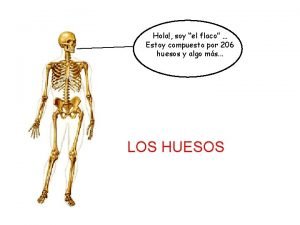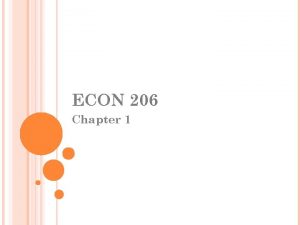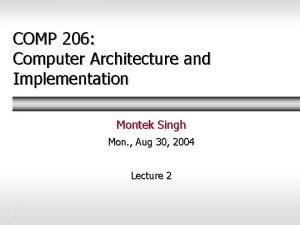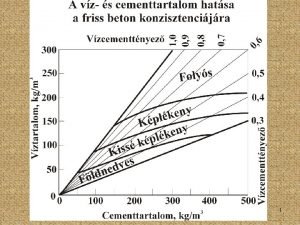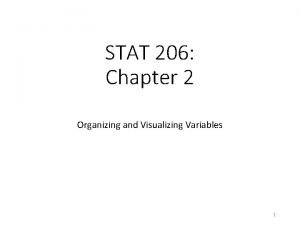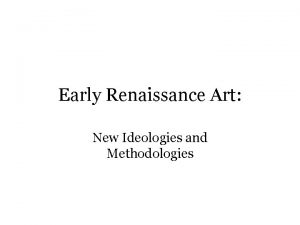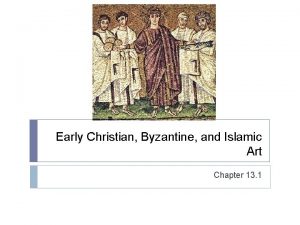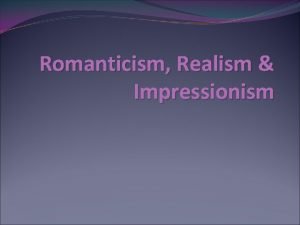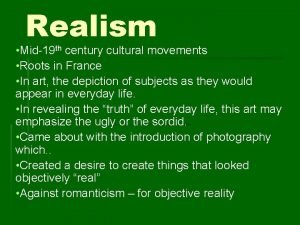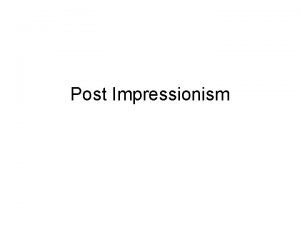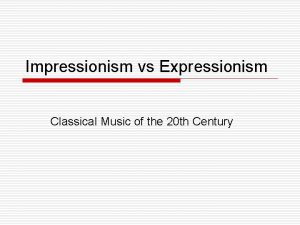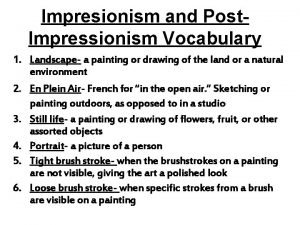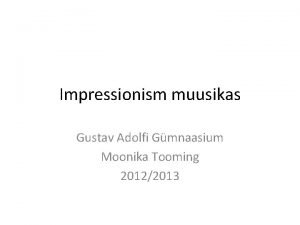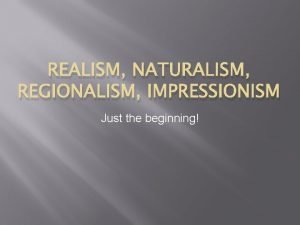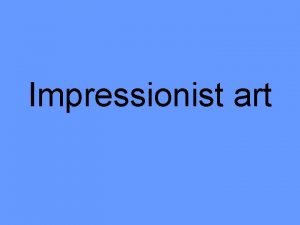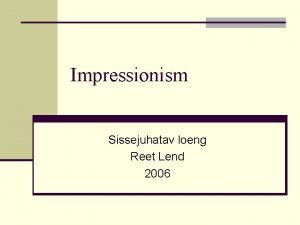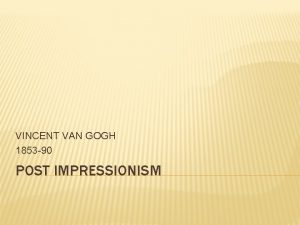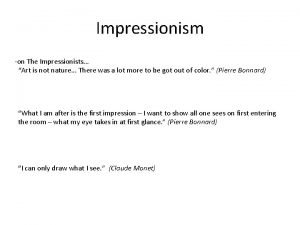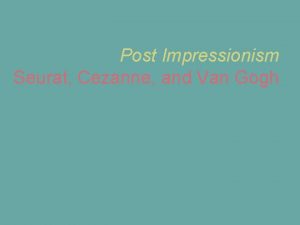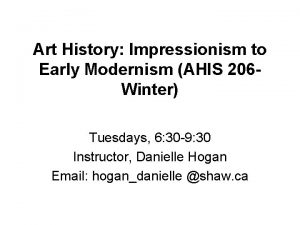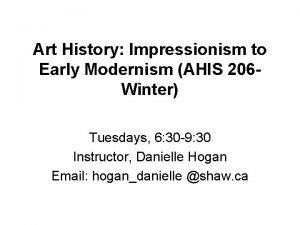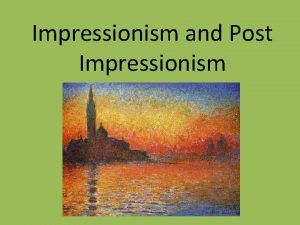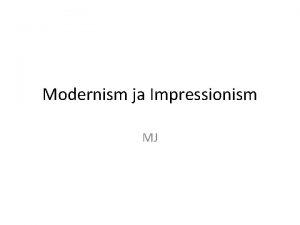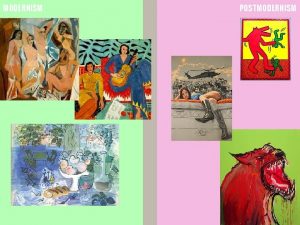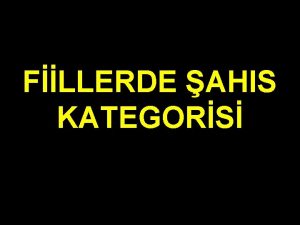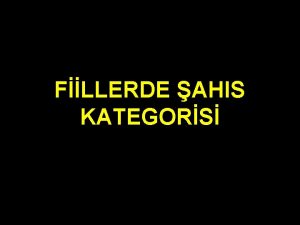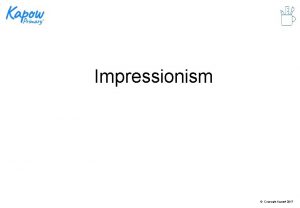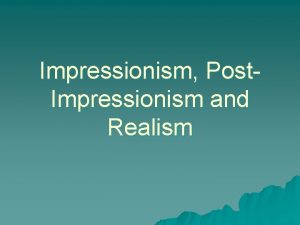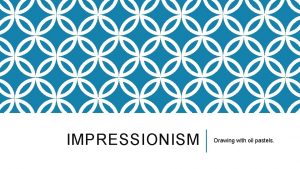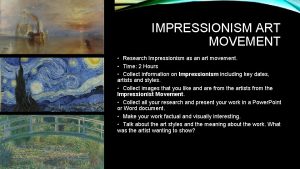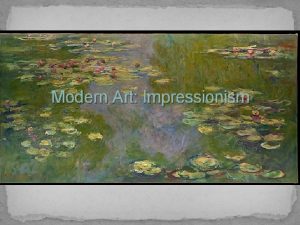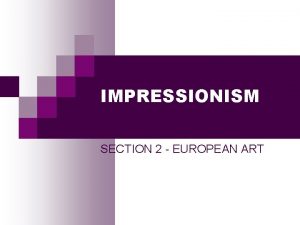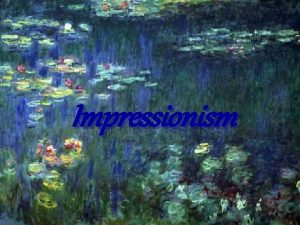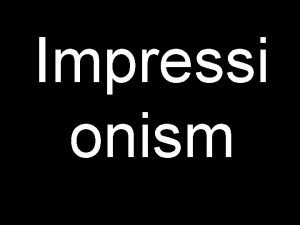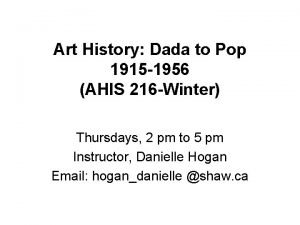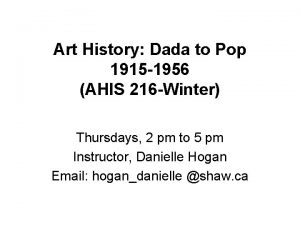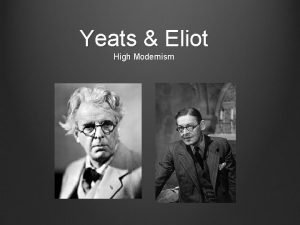Art History Impressionism to Early Modernism AHIS 206











































![Assemblage Raoul Hausmann (Mechanical Head [The Spirit of Our Age]) c. 1920 Assemblage Raoul Hausmann (Mechanical Head [The Spirit of Our Age]) c. 1920](https://slidetodoc.com/presentation_image_h/dbf8db4b66bdd26aa67c181d6cba1ee3/image-44.jpg)










- Slides: 54

Art History: Impressionism to Early Modernism (AHIS 206 Winter) Tuesdays, 6: 30 -9: 30 Instructor, Danielle Hogan Email: hogan_danielle @shaw. ca

World War I A major war centred in Europe that began on 28 July 1914 and lasted until 11 November 1918. It involved all the world's great powers.

Early Influences To evoke a "before", that is to try and establish Dada’s ancestry so as to better describe its history would be against the tenets of a movement that turned its back on all artistic, literary and cultural heritages. Dada considered itself as "born without a mother, " or as Tristan Tzara’s said: "I don’t even want to know if there have been men before me. " [Tristan Tzara, Manifeste Dada [» ] 1918, cover]. The Dadaists, who wanted to make a tabula rasa of history, nevertheless maintained an ambiguous relationship with their recent past. Even though they admired certain figures such as Apollinaire, they rejected previous influences, especially those of the Futurists, to whom they owed much in the realm of typography. TEXT CREDITS Jeanne Brun, 'Avant Dada', translated from the French text, published in the catalogue Dada (Editions du Centre Pompidou : Paris 2005) 122 -123. The translation was part of the Press Kit, published by MNAM Centre Pompidou 2005, p. 53 -55 [Press Kit. Courtesy MNAM Centre Pompidou].

DADA

You cannot define electricity. The same can be said of art. It is a kind of inner current in a human being, or something which needs no definition. Marcel Duchamp

Dada Responding to the disasters of World War 1 and to the an emerging modern media and machine culture, Dada artists led a creative revolution that boldly embraced and caustically criticized modernity itself. Proposing innovative strategies of art making, including collage, photomontage, chance, Readymades, performances and media pranks, the movement created an abiding artistic legacy for the century to come. Defiantly international relative to the pervasive nationalism of its day, Dada- active in Berlin, Cologne, Hannover, New York, Paris and Zurich- was the first avant-garde movement to self consciously position itself as a international network crossing countries and continents. -Mo. MA

The signatories of this manifesto have, under the battle cry DADA!!! gathered together to put forward a new art. What, then, is Dadaism? The word "Dada" signifies the most primitive relation to the reality of the environment. . Life appears as a simultaneous muddle of noises, colours and spiritual rhythms, which is taken unmodified, with all the sensational screams and fevers of its reckless everyday psyche and with all its brutal reality. . Dada is the international expression of our times, the great rebellion of artistic movements, the artistic reflex of all these offensives, peace congresses, riots in the vegetable market. . (Hughes, 71) DADA Manifesto was written in 1918.

Cabaret Voltaire Spiegelgasse 1, Zurich photographed in 1935

The Exquisite Corpse Drawing by Yves Tanguy, Man Ray, Max Morise, Joan Miró, c. 1926.

Marcel Duchamp 28 July 1887 – 2 October 1968

Nude Descending a Staircase no 2 1912 Oil on canvas Marcel Duchamp

To Be Looked at (from the Other Side of the Glass) with One Eye, Close to, for Almost an Hour Marcel Duchamp 1918 Oil, silver leaf, lead wire, and magnifying lens on glass (cracked), mounted between panes of glass in a standing metal frame, 20 1/8 x 16 1/4 x 1 1/2" (51 x 41. 2 x 3. 7 cm), on painted wood base, 1 7/8 x 17 7/8 x 4 1/2" (4. 8 x 45. 3 x 11. 4 cm), Overall 22" (55. 8 cm) high

LHOOQ 1919 Marcel Duchamp

Rrose Sélavy (Marcel Duchamp) Photograph by Man Ray 1921 Marcel Duchamp

READYMADES Readymades are everyday manufactured goods that are deemed to be art merely by virtue of the artist's selection of them as such. They were invented by Marcel Duchamp who wanted to test the limits of what qualifies as a work of art. Although he had collected manufactured objects in his studio in Paris, it was not until he came to New York in 1915 that he identified these objects as a category of art, giving the English name "readymade" to any object purchased "as a sculpture already made. " To common household goods, he added signatures and titles, converting them into works of art. When he modified these objects, for example by penning mustache and goatee on the color reproduction of the Mona Lisa, he called them "assisted" or "rectified readymades. " Duchamp's most scandalous readymade was the porcelain urinal that he turned on its back, titled Fountain, signed R. Mutt (a pun on the German word Armut, or poverty), and submitted to the supposedly jury-free exhibition at the Society of Independent Artists. When it was rejected, the dadaists launched a publicity campaign and defense of the work. -National Gallery of Art, Washington DC

Fountain 1917 readymade porcelain urinal on its back 63 x 48 x 35 cm Marcel Duchamp

Bottlerack 1914 Marcel Duchamp

The Readymade/Assemblage is an artistic process. In the visual arts, it consists of making threedimensional or two-dimensional artistic compositions by putting together found objects.

Bicycle Wheel 1913 Marcel Duchamp

Randomness and Chance


Autoportrait Man Ray

Cadeau (Gift) c. 1958 (replica of lost 1921 original) painted flat iron with row of tacks, heads glued to bottom Man Ray

Indestructible Object (or Object to Be Destroyed) Man Ray 1964 (replica of 1923 original) Metronome with cutout photograph of eye on pendulum 8 7/8 x 4 3/8 x 4 5/8" (22. 5 x 11. 6 cm).

Marquise Casati 1922 Man Ray

A photogram is a photographic image made without a camera by placing objects directly onto the surface of a light-sensitive material such as photographic paper and then exposing it to light. The usual result is a negative shadow image that shows variations in tone that depends upon the transparency of the objects used. Areas of the paper that have received no light appear white; those exposed through transparent or semi-transparent objects appear grey. [1] The techniquie is sometimes called cameraless photography. It was used by Man Ray in his exploration of rayographs. Photograms were used in the 20 th century by a number of photographers, particularly Man Ray, who called them "rayographs". His style capitalised on the stark and unexpected effects of negative imaging, unusual juxtapositions of identifiable objects (such as spoons and pearl necklaces), variations in the exposure time given to different objects within a single image, and moving objects as the sensitive materials were being exposed. [

Man Ray “Rayographs 1922 -28”

Man Ray

Man Ray

Indestructible Object (or Object to Be Destroyed) Man Ray 1964 (replica of 1923 original) Metronome with cutout photograph of eye on pendulum 8 7/8 x 4 3/8 x 4 5/8" (22. 5 x 11. 6 cm).

Fernand Léger 1922

Ballet mécanique Fernand Léger 1924 Black and white version. French intertitles. 12 min.

Our heads are round to let thought change direction. -Francis Picabia

391 first appeared in Jan 1917. Frances Picabia

The Fig-Leaf 1922 Oil on canvas 2062 x 1663 x 70 mm painting Frances Picabia

Jean Arp

Untitled (Collage with Squares Arranged According to the Laws of Chance) 1916 -17 Jean Arp

Tristan Tzara

Calligramme Tristan Tzara

Hugo Ball

Sound Poem Hugo Ball Proof sheet for the projected anthology Dadaco, edited by George Grosz, John Heartfield, et al, 1919.

Jean Cocteau

Raoul Hausmann
![Assemblage Raoul Hausmann Mechanical Head The Spirit of Our Age c 1920 Assemblage Raoul Hausmann (Mechanical Head [The Spirit of Our Age]) c. 1920](https://slidetodoc.com/presentation_image_h/dbf8db4b66bdd26aa67c181d6cba1ee3/image-44.jpg)
Assemblage Raoul Hausmann (Mechanical Head [The Spirit of Our Age]) c. 1920

Raoul Hausmann ABCD 1923 -1924

Hannah Höch self-portrait, c. 1926

Cut with the Dada Kitchen Knife through the Last Weimar Beer-Belly Cultural Epoch in Germany Hannah Höch 1919 collage of pasted papers, 90 x 144 cm

Hannah Höch collage of pasted papers

Hannah Höch collage of pasted papers

Hannah Höch collage of pasted papers

Hannah Höch collage of pasted papers

Hannah Höch collage of pasted papers

Hannah Höch collage of pasted papers

Hannah Höch collage of pasted papers
 Show me an angel and i'll paint one
Show me an angel and i'll paint one Impressionism vs post impressionism
Impressionism vs post impressionism How did renoir glamorize his clientele
How did renoir glamorize his clientele Monet
Monet Manet paintings
Manet paintings Early cpr and early defibrillation can: *
Early cpr and early defibrillation can: * The verb jugar (p. 208) answers
The verb jugar (p. 208) answers Ee206
Ee206 Comp 206
Comp 206 221 bce
221 bce Prop 206 pto
Prop 206 pto Csce 206 tamu
Csce 206 tamu Round 787 206 to the nearest ten
Round 787 206 to the nearest ten 206 tl
206 tl Sn en 206
Sn en 206 206 ossa
206 ossa 206 to binary
206 to binary La pelvis es un hueso largo corto o plano
La pelvis es un hueso largo corto o plano Econ 206
Econ 206 Comp 206
Comp 206 Common case fast
Common case fast Cnom beton
Cnom beton En 206
En 206 206 ptt
206 ptt Psir 206
Psir 206 Psir 206
Psir 206 Plan bus 206
Plan bus 206 Ee 206
Ee 206 Seattle utility discount program
Seattle utility discount program Stat 206
Stat 206 Comp 206
Comp 206 Characteristics of early renaissance art
Characteristics of early renaissance art Characteristics of early christian art
Characteristics of early christian art Lowenfeld and brittain stages of artistic development
Lowenfeld and brittain stages of artistic development Byzantine
Byzantine Realism vs romanticism art
Realism vs romanticism art Impressionism characteristics
Impressionism characteristics Post impressionism characteristics
Post impressionism characteristics La mer impressionism or expressionism
La mer impressionism or expressionism Expressionist vs impressionist
Expressionist vs impressionist Luncheon of the boating party analysis
Luncheon of the boating party analysis Where did impressionism originated
Where did impressionism originated Impresionism
Impresionism Post impressionism characteristics
Post impressionism characteristics Post impressionism slideshare
Post impressionism slideshare Pentatooniline helirida
Pentatooniline helirida Regionalism
Regionalism Impressionistic writing heart of darkness
Impressionistic writing heart of darkness Elbow impressionism
Elbow impressionism Impressionism information
Impressionism information Reet lend
Reet lend Van gogh post impressionism
Van gogh post impressionism Impressionism mind map
Impressionism mind map French impressionism in film
French impressionism in film Cezanne pointillism
Cezanne pointillism




